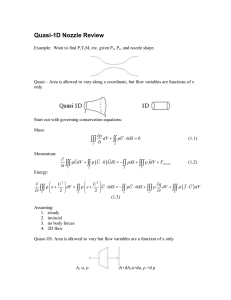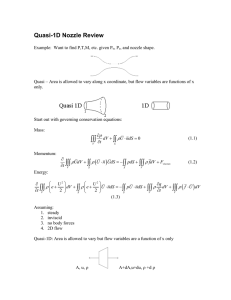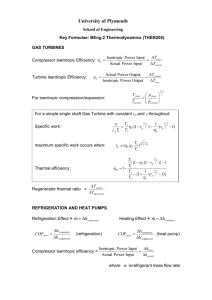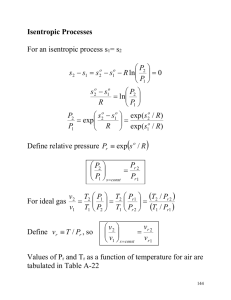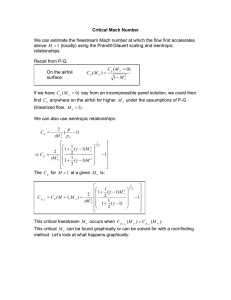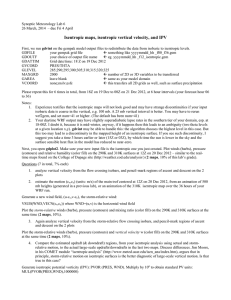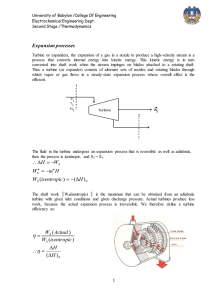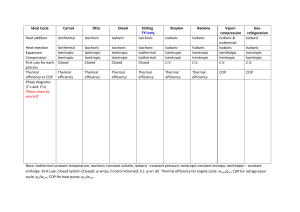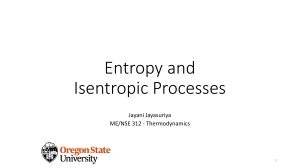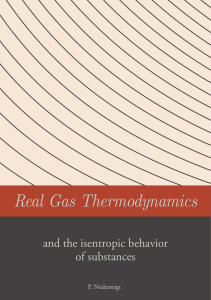ρ
advertisement
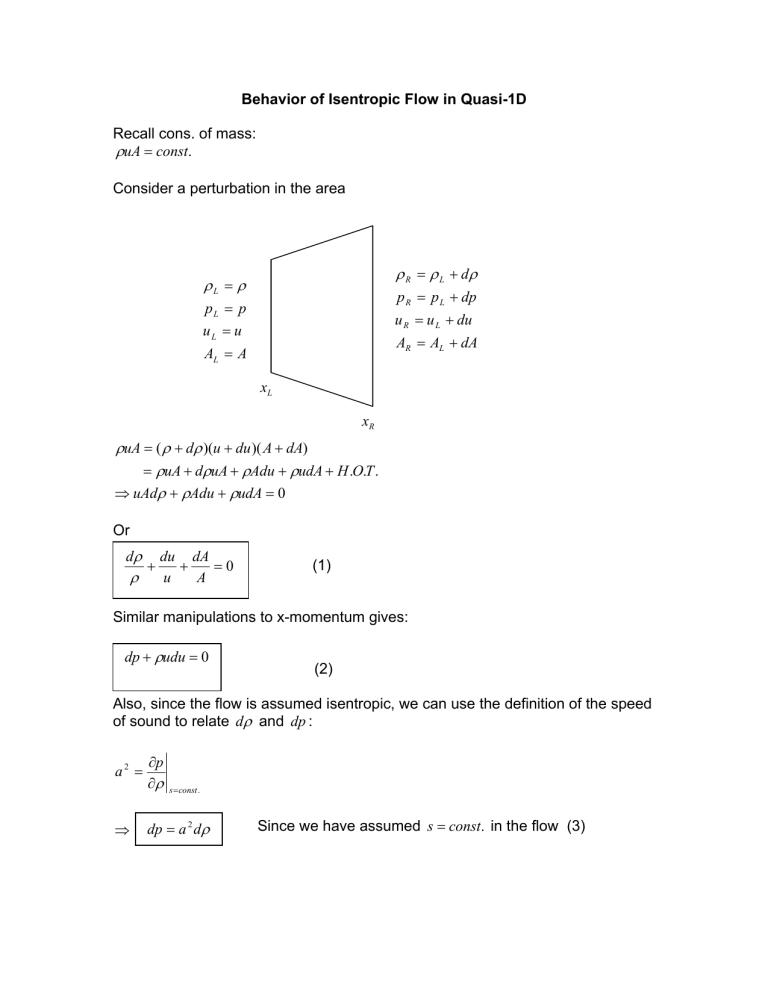
Behavior of Isentropic Flow in Quasi-1D Recall cons. of mass: ρuA = const. Consider a perturbation in the area ρ R = ρ L + dρ ρL = ρ p R = p L + dp pL = p u R = u L + du uL = u AR = AL + dA AL = A xL xR ρuA = ( ρ + dρ )(u + du )( A + dA) = ρuA + dρuA + ρAdu + ρudA + H .O.T . ⇒ uAdρ + ρAdu + ρudA = 0 Or dρ ρ + du dA + =0 u A (1) Similar manipulations to x-momentum gives: dp + ρudu = 0 (2) Also, since the flow is assumed isentropic, we can use the definition of the speed of sound to relate dρ and dp : a2 = ⇒ ∂p ∂ρ s = const . dp = a 2 dρ Since we have assumed s = const. in the flow (3) Behavior of Isentropic Flow in Quasi-1D We are interested in how the flow properties change when the area changes. So, we use (2) and (3) to eliminate terms from (1). For example, let’s determine how u changes with A : dρ du dA + =0 ρ u A dp du dA + + =0 A ρa 2 u ρudu du dA − + + =0 u A ρa 2 du dA (1 − M 2 ) + =0 u A ⇒ + du 1 dA =− u 1− M 2 A du dA > 0 when <0 u A ⇒ u increases when A decreases du dA ∗ < 0 when >0 u A ⇒ u decreases when A increases This is what we expect from our understanding of incompressible flow. When M < 1 : ∗ du dA > 0 when >0 u A ⇒ u increases when A increases! du dA ∗ < 0 when <0 u A ⇒ u decreases when A decreases! This is very different from incompressible flow. When M > 1 : ∗ What’s happening for M > 1 ? Clearly, ρu must behave the opposite of A regardless of the Mach number. So, what must be happening is that ρ changes more rapidly than A for M > 1 and, thus u behaves opposite of what we expect from subsonic flow behavior. Let’s check this: du 1 dA =− u 1− M 2 A dp 1 dA − 2 =− ρu 1− M 2 A dp 1 dA = 2 ρu 1− M 2 A 16.10 2002 2 Behavior of Isentropic Flow in Quasi-1D 1 dA a 2 dρ = 2 ρu 1− M 2 A dρ ρ = M 2 dA 1− M 2 A These results show that, regardless of whether M > 1 or M < 1 , dp and dρ have the same sign as dA : p, ρ ↑ when A ↑ p, ρ ↓ when A ↓ Recall conservation of mass: dρ ρ + du dA + =0 u A M2 1 dA dA dA − + =0 2 1− M 1− M 2 A A 1 dA dp = 2 ρu 1− M 2 A 1 dA a 2 dρ = 2 ρu 1− M 2 A dρ ρ = M 2 dA 1− M 2 A Thus we find that: M < 1 : p, ρ ↑ when A ↑ p, ρ ↓ when A ↓ M > 1 : p, ρ ↑ when A ↓ p, ρ ↓ when A ↑ Which are the opposite of how u behaves. It is also useful to consider the magnitudes of the different changes: 16.10 2002 3 Behavior of Isentropic Flow in Quasi-1D dρ ρ + du dA + =0 u A M 2 dA 1 dA dA − + =0 2 A 1− M A 1− M 2 A Flow low M , ρ changes are small compared to u changes. But for M > 1, ρ changes more rapidly. ∗ Also, of interest is that dρ , dp, and du become extremely large as M → 1 . ∗ In fact, this requires that M = 1 must occur at a minimum in the area where dA = 0 . Let’s consider a converging-diverging duct: pbach p0 When pbach is only a little less than p0 , the flow will be subsonic: M decreasing pbach 1 0 ∗ As pbach is lowered from p o , we will eventually hit the pbach at which M = 1 at the throat. What happens if pbach is lowered further? There is one other isentropic flow through this geometry which occurs when pbach is very low. In this situation, the flow will become supersonic in the divergent section: 16.10 2002 4 Behavior of Isentropic Flow in Quasi-1D M Supersonic isentropic flow (very low p bach ) 1 Subsonic isentropic flows 0 16.10 2002 5
